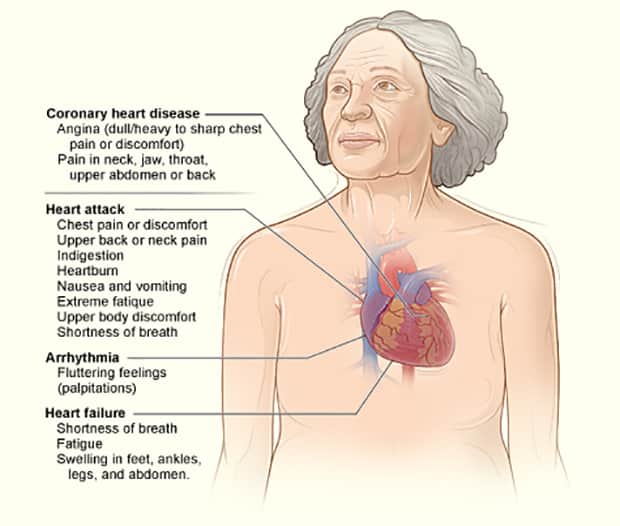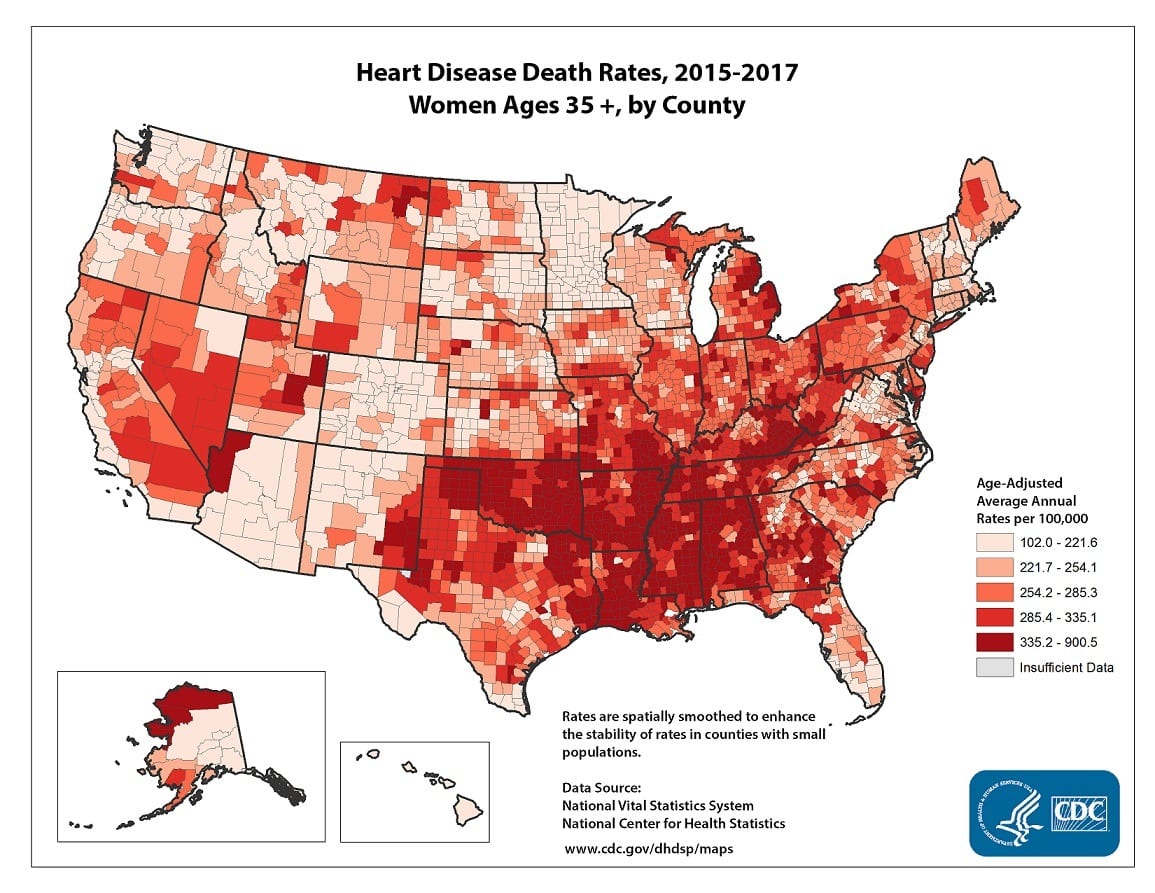
Women and Heart Disease: US statistics
Updated May 2023
Introduction
Heart disease is a significant health concern for women in the United States, yet a limited awareness of its impact persists. Despite progress in knowledge and understanding, many women underestimate the risk heart disease poses to their lives. This article explores the current statistics on heart disease in women, highlights the shifting perspectives surrounding women’s risk, and emphasizes the importance of proactive prevention. Additionally, it delves into the alarming disparities in maternal health, particularly among black women, and calls for urgent action to address these inequities.
Although heart disease is sometimes considered a man’s disease, almost as many women as men die each year of heart disease in the United States.
This map shows death rates from heart disease in women in the United States. The darker red indicates a higher death rate.
How does heart disease affect women?

Limited Awareness Persists: Women’s Misunderstanding of Heart Disease as the Primary Killer
Despite advancements in knowledge and understanding, only approximately half of women (56%) acknowledge that heart disease holds the top spot as their primary cause of death.1
Here are additional insights regarding women and heart disease:
Heart disease stands as the leading culprit behind female mortality in the United States, claiming the lives of 299,578 women in 2017, which equates to approximately 1 in every 5 female deaths.2
In the United States, heart disease occupies the top spot for both African American and white women in terms of mortality. Among American Indian and Alaska Native women, heart disease and cancer cause a nearly equal number of fatalities each year. As for Hispanic and Asian or Pacific Islander women, heart disease ranks second only to cancer as a leading cause of death. Cdc
Shifting Perspectives: Recognizing Women’s Risk of Heart Disease
Gone are the days when women only concerned themselves with heart disease as a threat to the men in their lives. It is now widely acknowledged that heart disease is not solely a man’s problem. In fact, coronary heart disease, the leading cause of death in the United States, affects women and men in nearly equal numbers.
Underappreciated Risk:
Despite increased awareness, a survey by the American Heart Association revealed that only around half of the women interviewed knew that heart disease is the primary cause of death in women. Surprisingly, only 13% identified it as their most significant personal health risk. This begs the question: if not heart disease, then what do women worry about? Data from the survey suggests that women remain more concerned about breast cancer daily, even though heart disease claims six times as many female lives annually. This disconnect raises concerns.
Factors Contributing to the Disconnect:
Breast cancer affects women’s body image, sexuality, and self-esteem in unique ways that a diagnosis of heart disease does not. Moreover, heart disease typically manifests at an older age, with the average woman experiencing her first heart attack at around 70. Consequently, younger women may not perceive the threat as immediate. While many 50-year-old women know others who have battled breast cancer, they may not personally know anyone who has dealt with heart disease.
Challenges in Diagnosis and Communication:
Adding to the issue, numerous women report that their physicians rarely discuss coronary risk with them and sometimes fail to recognize the symptoms. Instead, these symptoms are often mistaken for panic disorder, stress, or hypochondria. This further hampers women’s understanding and appreciation of their vulnerability to heart disease.
In conclusion, while progress has been made in raising awareness about heart disease in women, there is still work to be done. Overcoming the disconnect requires addressing the psychological and societal factors contributing to women underestimating their risk. Improved physician-patient communication and education can empower women to prioritize their heart health alongside other health concerns, ultimately reducing the impact of heart disease on women’s lives. Health Harvard
Taking Charge: Preventing Heart Attacks in Women
To safeguard oneself from heart attacks, reducing risk factors and being aware of warning signs is crucial, advises Dr Nieca Goldberg, a spokesperson for the American Heart Association (AHA). Given that coronary heart disease is the primary cause of death among women in the United States, taking an active patient role can save lives.
Understanding the Process:
The development of cholesterol-rich plaque on the walls of heart arteries, which eventually leads to coronary heart disease and heart attacks, begins in early childhood and progresses throughout one’s lifetime. When the plaque-narrowed artery restricts blood flow or bursts due to high blood pressure, a heart attack occurs.
Modifiable and Non-Modifiable Risk Factors:
While certain risk factors for heart disease, such as high blood pressure, poor diet, uncontrolled diabetes, and inactivity, can be modified, others, such as genetics and age, cannot be altered. The presence of multiple risk factors, such as being an overweight smoker with high blood pressure, increases the likelihood of experiencing a heart attack.
Proactive Steps for Prevention:
Initiating a conversation about heart health with your doctor and requesting appropriate testing and treatment is essential. Dr Goldberg emphasizes that the most effective solution is preventing heart disease before it leads to a heart attack. The following prevention tips, provided by the AHA, can help in this regard:
1. Manage blood pressure: Keep your blood pressure within a healthy range through lifestyle modifications and, if necessary, medication.
2. Adopt a heart-healthy diet: Consume a balanced diet rich in fruits, vegetables, whole grains, lean proteins, and low-fat dairy products, while limiting saturated and trans fats, sodium, and added sugars.
3. Engage in regular physical activity: Aim for at least 150 minutes of moderate-intensity aerobic exercise or 75 minutes of vigorous exercise each week, along with strength training exercises.
4. Maintain a healthy weight: Strive for a body weight within the recommended height and build range.
5. Quit smoking: Seek support and resources to quit smoking, as it significantly reduces heart attack risk.
6. Control diabetes: Manage diabetes through proper medication, regular monitoring, and adopting a healthy lifestyle.
7. Limit alcohol consumption: If you choose to drink alcohol, do so in moderation, keeping within the recommended limits.
8. Manage stress: Implement stress-reduction techniques such as exercise, relaxation exercises, and seeking support from loved ones.
9. Get regular check-ups: Stay up-to-date with preventive screenings and tests as your healthcare provider advises.
Other notes
By taking proactive steps to reduce modifiable risk factors and seeking appropriate medical guidance, women can actively protect their heart health and prevent heart attacks. Empowered patients who prioritize preventive measures can significantly improve their overall well-being and potentially save lives. Webmd
Why are black women at such high risk of dying from pregnancy complications?

Maternal Health Crisis: Addressing Racial Disparities and Saving Lives
Serena Williams and Beyoncé, renowned figures in their respective fields of tennis and music, have achieved unparalleled success. However, both these influential women encountered life-threatening complications during their pregnancies. In this aspect, they share a common experience with millions of other black women in the United States.
Alarming Disparities:
According to the Centers for Disease Control and Prevention, black women are three to four times more likely to die from pregnancy-related causes compared to white women. This significant disparity contributes to the overall rise in pregnancy-related deaths over the past two decades, making the maternal mortality rate in the United States the highest among industrialized nations, as reported in a 2016 analysis published in The Lancet. Dr. Ana Langer, Director of the Women and Health Initiative at the Harvard T.H. Chan School of Public Health, describes it as a public health and human rights emergency, with the potential for a significant number of these deaths to be preventable.
Complex Factors at Play:
Dr. Langer highlights that racial disparities in maternal health stem from complex factors like limited healthcare access and inadequate quality of care, particularly affecting women from lower socioeconomic backgrounds. To address this crisis, urgent action is needed. Key steps include enhancing access to quality care for all women, promoting culturally competent healthcare, providing implicit bias training, fostering community engagement and support, addressing social determinants of health, and advocating for policy reform. By tackling these multifaceted factors, we can strive for equitable and accessible care, ensuring safe and healthy pregnancies for every woman, regardless of race or socioeconomic status. Heart
Conclusion
The data presented in this article emphasises the significance of women’s heart health and the need for increased awareness and proactive measures to address heart disease. Despite advancements in knowledge, there remains limited awareness among women regarding heart disease as the primary cause of death. The statistics indicate that heart disease is the leading cause of female mortality in the United States, claiming the lives of many women each year.
Furthermore, it is crucial to recognise the shifting perspectives surrounding heart disease, as it is no longer considered solely a man’s problem. Both African American and white women face a higher risk of mortality from heart disease, with American Indian and Alaska Native women experiencing nearly equal fatalities from heart disease and cancer. Hispanic and Asian or Pacific Islander women also face a significant burden of heart disease as a leading cause of death.
The article highlights the disconnect between women’s perception of heart disease and its actual impact. While breast cancer often receives more attention and concern, heart disease proves to be a much greater threat, claiming six times as many lives annually. This disconnect may be attributed to the unique challenges posed by breast cancer, which affects body image, sexuality, and self-esteem, as well as the perception that heart disease primarily affects older women.
Challenges in diagnosis and communication further contribute to the underestimation of women’s vulnerability to heart disease. Many women report that physicians rarely discuss coronary risk with them, leading to misdiagnosis and delayed treatment. Addressing these challenges requires improved physician-patient communication, increased education, and raising awareness about the symptoms and risks of heart disease in women.
Preventing Heart Attacks and Addressing Racial Disparities
To prevent heart attacks and promote heart health in women, proactive steps must be taken. Modifiable risk factors such as high blood pressure, poor diet, inactivity, smoking, and uncontrolled diabetes should be addressed through lifestyle modifications and appropriate medical interventions. Implementing a heart-healthy diet, engaging in regular physical activity, maintaining a healthy weight, quitting smoking, controlling diabetes, managing stress, limiting alcohol consumption, and getting regular check-ups are essential preventive measures.
Moreover, it is crucial to acknowledge the alarming disparities in maternal health, particularly among black women. Black women are three to four times more likely to die from pregnancy-related causes compared to white women, highlighting a significant racial disparity. Limited access to healthcare, inadequate quality of care, and systemic issues such as poverty and racism contribute to this crisis. Addressing these disparities requires enhanced access to quality care, culturally competent healthcare, implicit bias training, community engagement and support, addressing social determinants of health, and advocating for policy reform.
In light of the data presented, it is evident that progress has been made in raising awareness about women’s heart health and maternal health disparities. However, there is still work to be done to bridge the gaps in understanding and ensure equitable care for all women. By addressing the psychological, societal, and systemic factors contributing to the underestimation of risk and disparities in healthcare, we can empower women to prioritise their heart health and promote better outcomes.
In summary, improving women’s heart health and reducing the impact of heart disease requires a multi-faceted approach encompassing awareness campaigns, education, improved communication between patients and healthcare providers, preventive measures, and addressing racial disparities in maternal health. By taking proactive steps and working together, we can strive towards a future where every woman has the knowledge, resources, and support to lead a heart-healthy life.
New Reads

Hidden Toxins in Organic Food: What You Need to Know

Financial Psychology: Seizing Opportunities Amid Crises

The Best Time to Travel to Indonesia: Top Destinations

Debunking the Myth: Russia and ISIS Working Together

Improper Data Manipulation Fueling Fake News

Religion in China: Exploring Religious Expression and Dynamics

NATO Provoking Russia: Unpacking the Dynamics

The Fall and decline of the American Empire

China Economy News: Growth Prospects for 2023-2024

Pushing Beyond the Hayflick Limit: New Horizons in Cellular Aging

Living Paycheck-to-Paycheck: Surviving or Thriving

Application of AI in Cybersecurity

Renowned Expert Exposes the Origins of the Cholesterol Scam

Federal Fraud: Government’s Persistent Financial Mismanagement

Coronavirus Mortality Rate: Media Hype?


